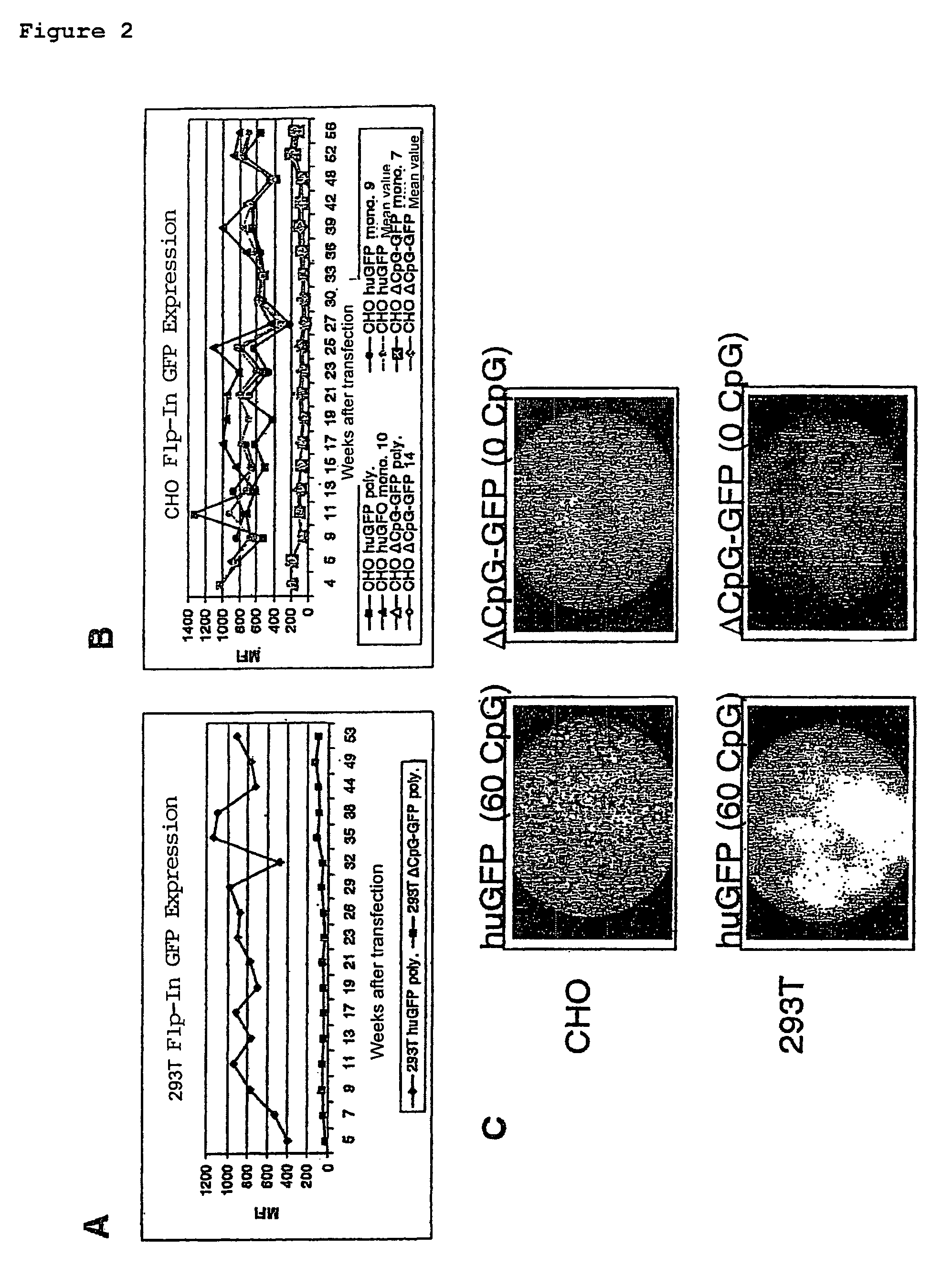Method for modulating gene expression by modifying the CpG content
a gene expression and content technology, applied in the field of gene expression modulation by modifying the cpg content, can solve the problems of uncontrolled multiplication of these cells, achieve the effects of general stabilisation of the rna, increase or reduce the number of cpg dinucleotides, and promote or inhibit gene expression
- Summary
- Abstract
- Description
- Claims
- Application Information
AI Technical Summary
Benefits of technology
Problems solved by technology
Method used
Image
Examples
example 1
Production of GFP Reporter Genes with Different CpG Content
[0114]Two variants of green fluorescence protein (GFP) genes, which differ in the number of CpG dinucleotides, were produced. The huGFP gene had 60 CpGs, the ΔCpG-GFP gene had no CpGs. The CpG-depleted gene ΔCpG-GFP was constructed artificially. In the design of the ΔCpG-GFP care was taken to ensure that no rare codons or negatively acting cis-active elements such as splicing sites or poly(A) signal sites were introduced. The codon adaptation index (CAI), which is a measure of the quality of the codon choice, was altered only slightly by the deletion of the CpGs (CaI(huGFP)=0.95; CAI (ΔCpG-GFP)=0.94). The coding amino acid sequence of the GFP was in this connection not altered. Further interfaces were inserted for the sub-cloning. The nucleotide and amino acid sequences are given in SEQ ID NO. 1 / 2.
[0115]The sequence was produced as a fully synthetic gene (Geneart GmbH), cloned into the expression vector pcDNA / 5FRT (Invitroge...
example 2
Production of Murine Mip1alpha Genes with Different CpG Contents
[0123]In this example the nucleic acid sequence of the murine MiP1alpha gene was altered so as to form a series of constructs with different numbers of CpG dinucleotides, but without altering the coding amino acid sequence. For this purpose the amino acid sequence of the murine MIP1alpha gene product was translated back into synthetic MIP1alpha-coding reading frames, using the codon choice of human cells. In a first series of constructs the accidentally formed CpG dinucleotides were removed stepwise from the sequence, without however introducing rare codons that would be expected to adversely affect the expression. In addition a CpG dinucleotide-optimised Mip1alpha gene construct was produced, which contained twice as many CpG dinucleotides as the codon-optimised construct. In this case a deterioration of the codon choice was intentionally taken into account, in order to introduce as many CpG dinucleotides as possible. ...
example 3
Production of Human and Murine Cytokine Genes with Different CpG Contents
[0133]In order to be able to further confirm the hitherto obtained results and interpretations, variants of the human MIP1alpha gene, of the human GM-CSF gene, of the human IL-15 gene and of the murine GM-CSF gene, which differ in the number of CpG dinucleotides from the wild-type gene, were artificially constructed similarly to Example 2 and sub-cloned into the expression vector pcDNA3.1 using the interfaces HindIII and NotI. The identification of the constructs, number of CpGs as well as the CAI values are given in Table 2. The nucleotide and amino acid sequences of the wild-type sequences (wt) and of the sequences with an altered number of CpG dinucleotides are given in SEQ ID NO. 17 / 18 to SEQ ID NO. 23 / 24 and SEQ ID NO. 48 / 49 to SEQ ID NO. 54 / 55. The expression constructs were amplified by means of a polymerase chain reaction (PCR) using the oligonucleotides humip-1 and humip-2, hugm-1 and hugm-2, huil-1 an...
PUM
| Property | Measurement | Unit |
|---|---|---|
| pH | aaaaa | aaaaa |
| pH | aaaaa | aaaaa |
| nucleic acid | aaaaa | aaaaa |
Abstract
Description
Claims
Application Information
 Login to View More
Login to View More - R&D
- Intellectual Property
- Life Sciences
- Materials
- Tech Scout
- Unparalleled Data Quality
- Higher Quality Content
- 60% Fewer Hallucinations
Browse by: Latest US Patents, China's latest patents, Technical Efficacy Thesaurus, Application Domain, Technology Topic, Popular Technical Reports.
© 2025 PatSnap. All rights reserved.Legal|Privacy policy|Modern Slavery Act Transparency Statement|Sitemap|About US| Contact US: help@patsnap.com



